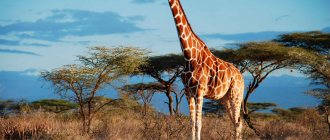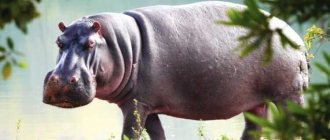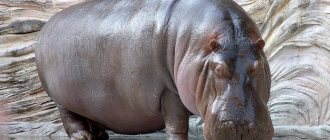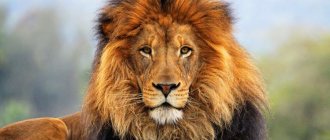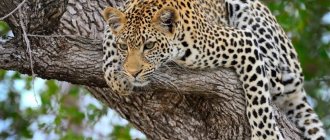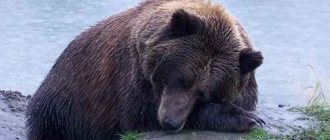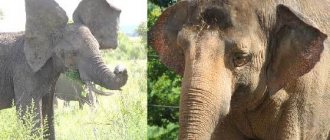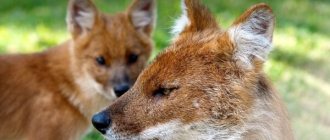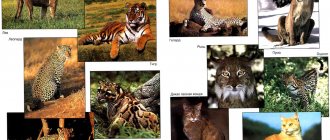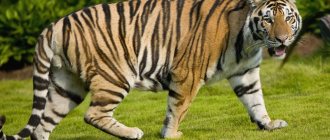The cheetah (Acinonyx jubatus) is a mammal of the cat family, genus Cheetah. This is the last representative of its kind; besides it, there are no cheetahs left on the planet. Its distinctive feature is that it is the fastest animal on Earth and can accelerate up to 120 km/h , and this cat also has semi-retractable claws - this feature is not found in other predators.
Description of the cheetah
The weight of adult cheetahs ranges from 40 to 65 kg, the body is 115-140 cm long, and the tail is about 80 cm long. The height of the animal is from 75 to 90 cm. The cheetah has a slender body, which seems fragile due to developed muscles and the absence of fat deposits. His head is small, his eyes are set high, and his ears are small and round in shape. The entire structure of the body is aimed at maximum streamlining during high-speed running. The volume of the chest and lungs is large enough for intense breathing when running. The cheetah is painted sandy yellow, decorated with small black spots, and has thin black stripes on the sides of its face. The cheetah is distinguished from most representatives of the cat family by partially retractable claws.
Appearance and morphology
Cheetahs are easy to distinguish from any other cats not only by the specific pattern on the skin, but also by their lean body, small head and long, thin, but at the same time strong legs. The body length of these animals is 123–150 cm; tail length 63–75 cm; height at withers about a meter; weight is usually 50–65 kg. The claws do not retract into the paw pads, a characteristic feature that distinguishes cheetahs from other cats. This structure of the claws provides the cheetah with excellent grip on the soil surface while running. The claws of the first toes on the front paws always remain sharp, as they never touch the ground. It is with their help that the predator knocks down its prey.
The tail is long, thin, evenly pubescent, and serves as an excellent rudder when running. The fur is short and sparse. Cubs have a rather long silvery mane that runs almost the entire length of the back; in adult animals, long, coarse hair remains only on the upper part of the neck to the shoulder blades. Small dark solid spots are densely scattered throughout the skin, except for the belly. The skull is high, light in structure, the facial region is shortened. 30 teeth.
Cheetah distribution
Today, cheetahs are widespread on the African continent: in Algeria, Angola, Benin, Botswana, Burkina Faso, Congo, Zambia, Zimbabwe, Kenya, Mozambique, Namibia, Niger, Somalia, Sudan, Tanzania, Togo, Uganda, Chad, Ethiopia and South Africa. In Asia, cheetahs survive only in Iran. Previously, the range of this species was much wider.
Common cheetah subspecies
There are five subspecies of cheetahs, four of which live in Africa and one in Asia. The African subspecies include the following:
- Acinonyx jubatus hecki: lives in northwest Africa and the Sahara;
- Acinonyx jubatus fearsoni: native to eastern Africa;
— Advertising —
- Acinonyx jubatus jubatus: distributed in southern Africa;
- Acinonyx jubatus soemmerringi: representative of northeastern Africa.
The Asian subspecies is called Acinonyx jubatus venaticus and is found in Iran.
Previously, it was distributed throughout the southeast of the continent, but now its population in this region barely numbers 60 individuals. The Asian subspecies differs from the African subspecies in having shorter legs, a powerful neck and thick skin. Cheetahs are not classified by color, but there are significant variations from the norm. Thus, there are black individuals and albino cheetahs, as well as red cheetahs, which have a golden color with dark red spots, light yellow and yellowish-brown animals with red spots.
Popular message topics
- Peas
Peas are an annual plant with a flexible climbing stem and light green leaves. Its long stems end in branched tendrils. It blooms with white or pale pink flowers, and when it fades, - Amazon River
The waters of the World Ocean are constantly renewed and replenished. This happens due to heavy rainfall, melting glaciers, underground springs and rivers carrying their waters to the oceans and seas. - Heroes of Space
We need to start the story about heroes of space with the people who made the flights themselves possible. The central figure on this list is rocket scientist K.E. Tsiolkovsky,
Cheetah behavior
Animals go hunting in the early morning or evening, when it is cool but light.
They rely more on sight than smell as a guide. Cheetahs do not attack from ambushes, but pursue prey, since their hunting takes place in open areas. First, the animal approaches the prey at about 10 m (without hiding), and then tries to catch it in a fast run. The cheetah will accelerate to 75 km/h in just 2 seconds; when running, it can make jumps of 6-8 m in length in 0.5 seconds. The breathing rate is 150 times per minute. A cheetah can quickly change direction of movement. Such a rapid run can last only 20 seconds and 400 m. And if it was not possible to catch up with the victim during this time, then the pursuit stops. This is why in about half of the cases the prey manages to escape. If the cheetah manages to catch up with the victim, he knocks it down with its front paw and strangles it. Despite the speed and large size of the cheetah, the hyena, leopard and lion often take prey from it while the animal is resting after running. The cheetah only eats prey that it kills on its own.
Nutrition
During twilight, this animal will hunt extremely infrequently and prefers to show energy only at dawn or at sunset, when the heat subsides. They most often watch for a trophy visually, and not by smell. Since there is nowhere to camouflage in the steppe, these cats do not attack when they see the impending victim, they chase it in several jumps, knock it down with a powerful blow with their paw and gnaw through an artery. The Cheetah feeds exclusively on gazelles, hares, and in some cases even ostriches.
Cheetah breeding
Male cheetahs usually gather in small groups that include brothers.
They fight with cheetahs of other groups for hunting territory and the females that are on it. Two male cheetahs usually hold their territory for about six months, and three - two years. In females, territorial behavior is not observed. During the breeding season, males usually pursue females for some time. The duration of pregnancy is 85-95 days, the female has 2-6 cubs in the litter. They are born small and defenseless, and can become easy prey for any predator, including an eagle. Their dark abdomen and white or gray fluffy “cape” are intended to give them away as honey badgers - ferocious predators that attack many animals. Up to three months, babies are distinguished by the presence of a mane in the scruff area and a tuft on the tail, by which females find them in the thickets. Milk feeding of babies continues until approximately 8 months. From 13 to 20 months they live with the female. The lifespan of a cheetah in the wild reaches 20-25 years; in zoos they live much longer, but at the same time they reproduce very poorly.
Cat family
Page 1 of 11
There are more than 30 species of animals in the cat family. From the ancestor of all cats, two main branches of feline development emerged: large and small cats.
Along with the miniature sand cat, the small cat subfamily includes domestic and small wild cats and large animals such as lynx, puma, and clouded leopard. They all share a common origin.
The big cat subfamily includes the lion, tiger, leopard and jaguar. The snow leopard and cheetah stand apart in the family.
All cats are created for hunting. There are no vegetarians or omnivores among them - only predators. They have everything designed for tracking down the victim and for killing: their eyes see in the dark, their ears hear the slightest rustle, their gait is silent, their jaws are powerful, their fangs are sharp, and their retractable claws, curved like sabers, are always sharpened.
Felines are poor runners. They are not pursuers, but lone ambush hunters. Hearing the approach of the prey, seeing it from afar, sneaking up, pressing its plastic body to the ground, jumping out at the prey, grabbing it with its claws and killing it - this is how cats hunt. The impetus for jumping without a run-up is provided by the hind legs, which are longer and stronger than the front legs. The claws, usually bent and hidden under the skin, are always sharp and grip deeply into the victim. The force behind the deadly bite is given by the jaws, which are shorter and therefore stronger than those of dogs.
Which cat roars like a lion?
All cats can be divided into growling and non-growling. Only in large species the larynx is connected to the skull by an elastic ligament. Small cats and cheetahs that do not have such a connection cannot growl.
The puma, or cougar, which belongs to small cats, although it weighs more than 90 kg, does not growl, but screams like a bird. It is doubtful whether this beast, also called the mountain lion, could roar, as is sometimes claimed. When he is happy, he purrs loudly. Small cats purr both when inhaling and exhaling, while large cats purr only when exhaling.
The cheetah screams just like a bird. Sometimes it makes a stuttering cry, similar to the cooing of a dove. These sounds are related to the processes of courtship and mating, and with other intonations they are used when communicating with cubs. There is a legend that a tiger can imitate the voice of its prey - a deer. In fact, the sound made by the tiger, slightly reminiscent of the voice of some deer, warns the hunter’s fellow hunters that he is near the prey and it is better for others to stay away.
Why do cats' eyes glow?
Experiments with domestic cats have shown that their eyes, compared to human eyes, are six times more sensitive in the blue part of the spectrum and adapt faster in the dark. This observation is believed to extend to wild cats. In a cat's eye, behind the retina, the layer of photoreceptors on the fundus of the eye, there are highly reflective cells that amplify weak light signals. That's why a cat's eyes glow when light hits them.
The structure of the pupil, through which light enters the eye, in cats is a compromise between the daytime and nighttime visual needs of the animal. As a rule, large cats have round pupils, while small ones have slit-shaped or spindle-shaped pupils, like domestic cats. A slit pupil, like a round one, can contract and expand.
Leopard
Leopards are the most prosperous species in the genus of big cats. Leopards live throughout almost all of Africa and Asia, from Turkey to India and the Far East. They have adapted to live in savannahs, deserts, mountains, jungles and even in the cold taiga - the rarest ones live there - the Far Eastern leopards, with warm fur. Being the smallest of the big cats, the leopard is not inferior to them in strength and hunts the same game: large antelopes, zebras, wild pigs. In the absence of large prey, the leopard catches rodents, fish and even insects. The ability to adapt to any conditions ensured the well-being of leopards.
Leopards, unlike lions, tigers and jaguars, are excellent tree climbers, which expands their hunting capabilities: they chase monkeys and birds in tree branches. African leopards drag their prey into trees. There, away from land predators, thieving lions and hyenas, the leopard can calmly have a snack and leave the remains of its meal until next time, without fear of being snatched away.
The leopard, with its spotted skin like a cheetah and its powerful build like a lion, got its name from both: “leopard.” Leopards were also called leopards and panthers. Panthers are more often called large black cats. Did you know that the black panther and the spotted leopard are the same animal? In nature, it happens that colored animals give birth to cubs that are devoid of color - albinos with white fur, light skin and red eyes. And vice versa, an excess of dark matter leads to the appearance of black animals - melanists. Leopards are more likely to give birth to melanists than other animals. Black panthers are melanistic leopards. If you look closely, even darker “leopard-print” spots are visible on the skin of a black panther.
The dark color camouflages the panther in the twilight of the jungle, without interfering with a successful hunt. A black hunter cannot hide in a light savanna; it is more difficult for him to get food, and it is more difficult for him to survive. Therefore, panthers are more often found in the jungle, but they rarely survive in the savannas.
- To the begining
- Back
- 1
- Forward
- In the end
Natural enemies of the cheetah
The range and number of cheetahs have decreased significantly in recent years.
The main reasons for the decline in their population are the reduction in the number of wild ungulates and hunting for them. Cheetahs live in open areas, and therefore become quite easy prey for humans. In addition, they do not reproduce in captivity, and the mortality rate among cubs is very high. At the beginning of the 21st century, there were approximately 4,500 adult cheetahs living in Africa. The Asian population today is catastrophically small (only about 60 animals), which is due to their long-term catching for training in hunting with humans.
Main threats
Every day, cheetahs face many threats that they have to overcome. But since they do not flock in large flocks, they mostly face problems alone.
Habitat loss and fragmentation
Cheetahs prefer to hunt in pre-demarcated territories, but gradual displacement by other predators and migration of prey often leaves them without food. These animals do not like to explore new lands, but when need forces them, they often do it incorrectly, settling in places where there are no populations of animals included in their diet.
Predators
Hyenas are the main enemies of cheetahs. The cheetah pays for its ability to develop high speed with a fragile body and light weight, which is why it is not able to fight on equal terms with large predators. And if an adult can run away from danger at a speed of 130 km/h, then cheetah cubs often become prey for lions, hyenas and other enemies.
Inbreeding
Due to their small population, cheetahs often mate with their closest relatives. Based on this, the offspring develop a genetic deficiency. This leads to decreased immunity, frequent illnesses and other problems.
Unorganized tourism
A large influx of tourists in the area where cheetahs live often prevents the animals from hunting. Despite the fact that predators are not afraid of people, the latter can scare away prey and drive it away over long distances.
Trade
Poachers catch cheetahs and put them in cages. Unfortunately, the trade in cheetahs is highly developed in the modern world. Poachers catch them, put them in cages and sell them illegally. In captivity, despite potentially good conditions, the cheetah does not have the opportunity to reproduce, which also leads to the gradual disappearance of the animals.
Interesting facts about the cheetah
- In the 10th-11th centuries, hunting saigas with cheetahs was popular in the East. The hunting cheetah was called pardus and was highly valued. Only rich princes kept such animals. Before the hunt, their eyes were covered with special caps and they were led out on leashes or tied behind horses. After surrounding a herd of antelope or deer, the cheetahs' caps were removed, untied, and they rushed to the prey. Pardus were trained to hold the prey until the hunter approached. And as a reward they were given the insides of the prey. A cheetah trained to hunt was considered a royal gift. Their high cost was due to the fact that cheetahs did not reproduce in captivity, and young animals had to be specially captured for the purpose of training.
- Akbar, a ruler from India who lived in the 16th century, is known as a passionate lover of hunting with cheetahs: about 1,000 of these animals were kept at one time in his court, and during his reign, approximately 9,000 individuals changed. Only one pair of them gave birth once. Due to the constant capture of cheetahs, the animal population in these areas has also decreased significantly.
- There is a mention of cheetahs in “The Tale of Igor’s Campaign,” and they are also the heroes of many literary works and films.
- It is not for nothing that cheetahs are recognized as the fastest animals in the world. The world record in the 100-meter dash among animals was set in 2012 by female cheetah Sarah (USA), who ran the distance in 5.95 seconds.
Evolution
Cheetahs boast some pretty interesting evolution and development. When their population declined sharply during the Ice Age, and the surviving individuals managed to adapt to the surrounding conditions, they needed to restore their numbers. Because of this, inbreeding of related animals began, which gave rise to the effect of homogamy.
Two cheetahs from the same population
Yes, this made it possible to quickly reproduce and populate the planet, but due to the appearance of cubs from close relatives, their gene pool was disrupted. Because of this, the animals are still paying the price. Now almost all cheetahs are so similar in DNA that individuals from neighboring populations may well be considered close blood relatives.
Given this characteristic, it is not surprising that newborn cheetah cubs can have health problems and often do not live beyond the age of one year, facing severe health problems. This is a clear example of how evolution can have a negative effect.
Scientists around the world are trying to find a way to help animals, but so far they have not been able to stop genetic degeneration.
Interesting:
The strangest animals in the world
